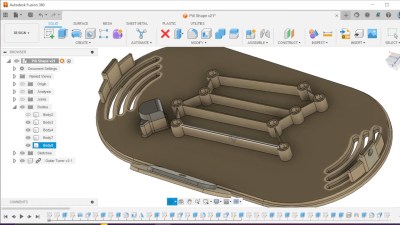Wouldn’t you love to be able to play a song on a stringed instrument even though you don’t have an iota of musical talent? That’s the idea behind Strumli, a single-string instrument built by [Factorem] that plays “the lick”. You know, the lick. Chances are, you’ve heard it somewhere before.
 Essentially, it’s a pill-shaped bowl with a soundboard. A high-E guitar string is wound around bearings and tuned with a guitar tuner. The lengths of string between the bearings correspond to each note in the lick. Strum it in the right direction, and Bob’s your uncle.
Essentially, it’s a pill-shaped bowl with a soundboard. A high-E guitar string is wound around bearings and tuned with a guitar tuner. The lengths of string between the bearings correspond to each note in the lick. Strum it in the right direction, and Bob’s your uncle.
So how the heck did [Factorem] come up with the proper string lengths needed to play the song? After a bit of fancy math involving the equation that represents the relationship between the measurable frequency of a vibrating string under tension and the tension itself, [Factorem] had the overall length of the string. Then it was a matter of finding the frequencies needed to play the lick, along with their corresponding lengths.
Since the string exerts about 80 pounds of tension across the 3D-printed soundboard, some serious internal bracing is required, which [Factorem] figured out in CAD program. All the files are available if you want to build your own. Be sure to check out the build/demo after the break.
Would you rather just build a little harp? Here’s the inspiration for Strumli — a single-string number with a full octave.
















Interesting idea. I have no interest in a human playable one but it is an interesting concept for things that get played by machine, from rolling ball sculptures to clocks. As long as there is enough tension on the strings for them to vibrate, they will be in tune. Clever.
We are Rickrolled @ 3:34 !!!
Nice try Kristina! ;)
I thought it was the theme from “Bridge over the River Kwai”.
(Willing to admit that I am wrong)
madness!
Nice try? He Rick rolled us so it’s not a try.
But good job kristina.
To be fair, I got you @ 2:30 too :P
Looking at the first photo I hoped the device was different. Hard to explain but I’ll try.
It would be super awesome if the little rollers moved back and forth so that you play the notes then they shift and a whole different set gets played. That way someone tone deaf and useless musically like me could play a song instead of just one little riff over and over.
I guess for performance art you could make several of the devices in the article that play different parts and then just use different boxes for the various parts of the song.
In any case this thing is cool and hopefully useful to those that have tried and fails to be musically inclined over and over again.
Something like the music boxes that work with punched paper?
It’s quite an interesting thought experiment to imagine how to make something like you describe, I think you’d need a linear actuator per note, and some way to keep constant tension. Perhaps the constant tension part could be done just with a hanging weight (if there’s some neat mechanical way to keep constant tension on a string please let me know).
It is interesting, I think the range of songs would be pretty limited though, the total string length of the sequence would have to be roughly the same so that the total string amount under tension would stay constant. That would mean the amount of note variance allowed would be pretty small, and probably not very musical. There are some cool mechanical systems to keep constant tension, Look up Evertune for guitar. The simplest one is definitely just hanging a weight on a string though.
A spring loaded idler bearing could provide tension. Just have an extra length of wire, at 90 degrees at one end where the tension could be applied.
„With only one string you can’t go wrong
So go ahead and make yourself a song
Make it kinda funky everybody gonna know” ;)
Seems like a great project start for using a laser cutter on plywood…
Also,
I think I would try to use as much of the length of the box as possible. Have it sound more like an instrument, and less like someone’s strumming the strings beyond the nut or bridge of a guitar.
Would require a ditty in a lower register, but that’s really just another improvement …